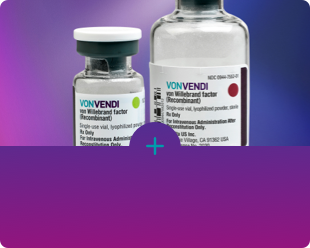VONVENDI for Prophylaxis Treatment
Indications
VONVENDI [von Willebrand factor (recombinant)] is indicated in adult and pediatric patients with von Willebrand disease (VWD) for1:
- On-demand treatment and control of bleeding episodes.
- Perioperative management of bleeding.
For adult patients only:
- Routine prophylaxis to reduce the frequency of bleeding episodes.
VONVENDI prophylaxis reduced the number of bleeds in adults previously treating bleeds on-demand1
91.7% (11/12) of adults achieved treatment success reducing their ABR with VONVENDI prophylaxis, with treatment success defined as at least a 25% reduction in a patient’s historical ABR (12 months prior to study) for spontaneous bleeding episodes requiring factor treatment vs the on-study period of 12 months.1

Pre-study and On-Study ABR was also assessed for All Spontaneous and Traumatic Bleeds and All Joint Bleeds. The median ABR for All Spontaneous and Traumatic Bleeds decreased from 4.5 to 0.5 and the ABR for All Joint Bleeds decreased from 1.5 to 0.1
*Based on descriptive statistics.1 †Based on bleeding and treatment history documented in medical records prior to the study.1
ABR=Annualized Bleed Rate; ALT=alanine aminotransferase; OD=on-demand; pdVWF=Plasma-derived Von Willebrand Factor; TEAE=treatment-emergent adverse event.

Study description
VONVENDI for routine prophylaxis was evaluated in a prospective, single-arm, open-label, international multicenter study enrolling 23 adults with VWD. Subjects were assigned by prior therapy to: a Prior on-demand group (n=12) or a Switch group previously on pdVWF prophylaxis (n=10), and received treatment for 12 months. The Prior on-demand group initiated VONVENDI at 50 ± 10 IU/kg twice weekly, while the Switch group received a starting VONVENDI dose matched (±10%) to their prior pdVWF regimen. Efficacy was measured by annualized bleeding rates for all bleeds, spontaneous bleeds, and joint bleeds.1
Study safety
Among patients who received prophylaxis with VONVENDI in the clinical trial, 17/23 (74%) experienced a total of 41 TEAEs. The following TEAEs were experienced by multiple subjects: headache (4 subjects), arthralgia (3 subjects), and ear infections, gastroenteritis, urinary tract infection (UTI), joint injury, and ALT increased (2 subjects each). Of these TEAEs, 1 report of headache (nonserious, moderate intensity) was considered related to VONVENDI and led to study discontinuation.2,3
Learn more about VONVENDI's established safety profile.
A majority of adult patients on pdVWF prophylaxis achieved treatment success after switching to VONVENDI prophylaxis1
For the Switch group in the VONVENDI prophylaxis study: 90% (9/10) of patients achieved treatment success, defined as achieving an on-study ABR (for 12 months) for spontaneous bleeding episodes requiring factor treatment that was no greater than their historical ABR (12 months prior to study) for treated episodes (preservation success).1,2

Pre-study and on-study ABR was also assessed for all spontaneous and traumatic bleeds and all joint bleeds. The median ABR for all spontaneous and traumatic bleeds increased from 1.0 to 3.6, and the ABR for all joint bleeds remained at 01
*Based on descriptive statistics.1
†Based on bleeding and treatment history documented in medical records prior to the study.1
With VONVENDI prophylaxis, the majority of bleeds in adult Type 3 VWD patients were mild or moderate2
- In adult patients with Type 3 VWD previously treated on demand, the majority of bleeding events with VONVENDI prophylaxis were mild or moderate.2*
- Adult Type 3 patients experienced 201 historical on-demand bleeds versus 38 total treated and untreated bleeds on study2*

Limitations
This secondary outcomes analysis is based on descriptive statistics and is from a sample size of 10 patients; therefore, results should be interpreted with caution2
*Total treated/untreated (201) vs on study (38).2
†Through Month 12.2
‡Other mucosa includes gum, mouth, and nose bleeds.2
§Patients with VWD Type 3 who were treated on-demand with any VWF during the 12-month period before entering this study.2
¶Historical.2
VONVENDI prophylaxis increased FVIII levels2
In adult patients with Type 3 VWD previously treated on-demand, VONVENDI prophylaxis increased trough FVIII levels 5-fold from baseline* and remained stable throughout 12 months of treatment with no additional prophylactic FVIII.2
Mean ± SD FVIII:C Trough Levels For Adult Patients With Type 3 VWD Treated With rVWF Prophylaxis and Available PK/PD Data: (A) Prior OD Group2

*Baseline visit, within 42 days of screening, after washout.2
rVWF=recombinant von Willebrand factor
VONVENDI prophylaxis led to a sustained FVIII rise in adult patients with severe Type 3 VWD1,2
- Pre-dose FVlll:C (FVlll level before VONVENDI administration) was evaluated in severe Type 3 VWD adults enrolled in the prophylaxis trial who were previously receiving on-demand therapy
- This analysis was performed at baseline (before the first dose of VONVENDI prophylaxis) and before VONVENDI prophylaxis dosing at Months 1, 2, 3, 6, 9, and 12

Treatment of breakthrough bleeds should follow the on-demand dosing guidelines.1
Consider self-infusion with VONVENDI for your adult patients with VWD
Review Safety Data
See the overall safety profile and adverse events for VONVENDI
Review Dosing by Indication
Prophylaxis, on-demand, and perioperative dosing for VONVENDI1
Contact a Takeda Rep
Get in touch with a Takeda representative in your area
References
- VONVENDI [von Willebrand factor (Recombinant)] Prescribing Information.
- Leebeek FWG, Peyvandi F, Tiede A, et al. Prophylaxis with recombinant von Willebrand factor in patients with type 3 von Willebrand disease: results of a post hoc analysis from a phase 3 trial. Eur J Haematol. 2023;111(1):29-40.
- Leebeek FWG, Peyvandi F, Escobar M, et al. Recombinant von Willebrand factor prophylaxis in patients with severe von Willebrand disease: phase 3 study results. Blood. 2022;140(2):89-98.


